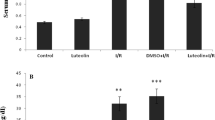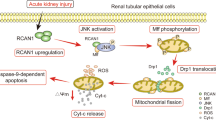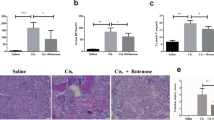Abstract
The current study was prepared to assess the underlying mechanism of diclofenac (Diclo)-stimulated renal oxidative damage (50 mg/kg/day for two consecutive days I.P) and antioxidative, and antiapoptotic effects of Thymoquinone (20 mg/kg/day for 21 days P.O). Exposure of rats to Diclo significantly increased serum urea and creatinine, decreased GSH, catalase, and total antioxidant capacity with a concomitant increase of lipid peroxidation. Diclo significantly decreased renal mitochondrial viability %, increased DNA fragmentation %, caspase 3 activity, and cytochrome C (Cyt C) concentration. Molecular investigations revealed that Diclo administration caused a significant reduction of mitofusin-2 (Mfn2) and increase of microRNA-34a (miR-34a) mRNA expressions with a concomitant decrease of Nrf2 and HO-1 mRNA expressions/protein levels and increase of NF-κB mRNA expressions. Thymoquinone restored renal oxidative/antioxidant redox. Thymoquinone significantly increased the renal mitochondrial viability % and reduced renal DNA fragmentation %, caspase 3 activity, and Cyt C. Moreover, thymoquinone modulated renal Mfn2 and miR-34a as compared to Diclo group. Our findings were confirmed by immunohistochemical assays for detecting the iNOS and NOX4 in renal tissue as well as histopathological investigations. Obtained results demonstrated that thymoquinone possess a potential antioxidant, antiapoptotic defense and exhibited a strong nephroprotective activity against Diclo-induced toxicity.






Similar content being viewed by others
Data availability
Supplementary data and materials are available to authorized users.
Change history
11 April 2024
Editor's Note: Readers are alerted that the concerns have been raised with this article. Editorial action will be taken as appropriate once this matter is resolved and all parties have been given an opportunity to respond in full.
References
Abraham E (2003) Nuclear factor-kappaB and its role in sepsis-associated organ failure. J Infect Dis 187(Suppl 2):S364–S369
Aebi H (1984) Catalase in vitro. Methods Enzymol 105:121–126. https://doi.org/10.1016/S0076-6879(84)05016-3
Akchurin OM, Kaskel F (2015) Update on inflammation in chronic kidney disease. Blood Purif 39:84–92
Andersson G, Karlberg O, Canbäck B, Kurland CG (2003) On the origin of mitochondria: a genomics perspective. Philosophical Transactions of the Royal Society of London. Ser B Biol Sci 358:165–179
Avery SV (2011) Molecular targets of oxidative stress. Biochem J 434:201–210
Awad AS, Kamel R, Sherief MA (2011) Effect of thymoquinone on hepatorenal dysfunction and alteration of CYP3A1 and spermidine/spermine N-1-acetyl-transferase gene expression induced by renal ischaemia-reperfusion in rats. J Pharm Pharmacol 63:1037–1042
Bach D, Pich S, Soriano FX, Vega N, Baumgartner B, Oriola J, Daugaard JR, Lloberas J, Camps M, Zierath JR, Rabasa-Lhoret R, Wallberg-Henriksson H, Laville M, Palacin M, Vidal H, Rivera F, Brand M, Zorzano A (2003) Mitofusin-2 determines mitochondrial network architecture and mitochondrial metabolism. A novel regulatory mechanism altered in obesity. J Biol Chem 278:17190–17197
Baldwin AS Jr (2001) Series introduction: the transcription factor NF-kappaB and human disease. J Clin Invest 107:3–6
Bancroft JD, Gamble M (2008) Theory and practice of histological techniques. Elsevier health sciences
Banerjee S, Kaseb AO, Wang Z, Kong D, Mohammad M, Padhye S, Sarkar FH, Mohammad RM (2009) Antitumor activity of gemcitabine and oxaliplatin is augmented by thymoquinone in pancreatic cancer. Cancer Res 69:5575–5583
Baravalia Y, Vaghasiya Y, Chanda S (2011) Hepatoprotective effect of Woodfordia fruticosa Kurz flowers on diclofenac sodium induced liver toxicity in rats. Asian Pac J Trop Med 4:342–346
Beutler E (1963) Improved method for the determination of blood glutathione. J Lab Clin Med 61:882–888
Bhatt K, Zhou L, Mi QS, Huang S, She JX, Dong Z (2010) MicroRNA-34a is induced via p53 during cisplatin nephrotoxicity and contributes to cell survival. Mol Med 16:409–416
Bhatt K, Mi QS, Dong Z (2011) microRNAs in kidneys: biogenesis, regulation, and pathophysiological roles. Am J Physiol Ren Physiol 300:F602–F610
Buege JA, Aust SD (1978) Microsomal lipid peroxidation. Methods Enzymol 52:302–310
Burton K (1956) A study of the conditions and mechanism of the diphenylamine reaction for the colorimetric estimation of deoxyribonucleic acid. Biochem J 62:315–323
Choi JH, Kang JW, Kim DW, Sung YK, Lee SM (2011) Protective effects of Mg-CUD against D-galactosamine-induced hepatotoxicity in rats. Eur J Pharmacol 657:138–143
de Brito OM, Scorrano L (2009) Mitofusin-2 regulates mitochondrial and endoplasmic reticulum morphology and tethering: the role of Ras. Mitochondrion 9:222–226
Ding Y, Gao H, Zhao L, Wang X, Zheng M (2015) Mitofusin 2-deficiency suppresses cell proliferation through disturbance of autophagy. PLoS One 10:e0121328
Dreiem A, Gertz CC, Seegal RF (2005) The effects of methylmercury on mitochondrial function and reactive oxygen species formation in rat striatal synaptosomes are age-dependent. Toxicol Sci 87:156–162
El Gazzar MA, El Mezayen R, Nicolls MR, Dreskin SC (2007) Thymoquinone attenuates proinflammatory responses in lipopolysaccharide-activated mast cells by modulating NF-kappaB nuclear transactivation. Biochim Biophys Acta 1770:556–564
El-Maddawy ZK, El-Ashmawy IM (2013) Hepato-renal and hematological effects of diclofenac sodium in rats. Glob J Pharmacol 7:123–132
Enomoto A, Itoh K, Nagayoshi E, Haruta J, Kimura T, O’Connor T, Harada T, Yamamoto M (2001) High sensitivity of Nrf2 knockout mice to acetaminophen hepatotoxicity associated with decreased expression of ARE-regulated drug metabolizing enzymes and antioxidant genes. Toxicol Sci 59:169–177
Fan PC, Chen CC, Chen YC, Chang YS, Chu PH (2016) MicroRNAs in acute kidney injury. Hum Genomics 10:29
Fattori V, Borghi SM, Guazelli CFS, Giroldo AC, Crespigio J, Bussmann AJC, Coelho-Silva L, Ludwig NG, Mazzuco TL, Casagrande R, Verri WA Jr (2017) Vinpocetine reduces diclofenac-induced acute kidney injury through inhibition of oxidative stress, apoptosis, cytokine production, and NF-kappaB activation in mice. Pharmacol Res 120:10–22
Fayez AMAA, El-Naa MM, Kenawy SA, El-Sayed ME (2014) Beneficial effects of thymoquinone and omega-3 in intestinal ischemia/R-induced renal dysfunction in rats. BFOP-CU 52:171–177
Gali-Muhtasib H, Roessner A, Schneider-Stock R (2006) Thymoquinone: a promising anti-cancer drug from natural sources. Int J Biochem Cell Biol 38:1249–1253
Giridharan R, Sabina EP (2017) Suppressive effect of Spirulina fusiformis on diclofenac-induced hepato-renal injury and gastrointestinal ulcer in Wistar albino rats: a biochemical and histological approach. Biomed Pharmacother 88:11–18
Gunes S, Sahinturk V, Uslu S, Ayhanci A, Kacar S, Uyar R (2018) Protective effects of selenium on cyclophosphamide-induced oxidative stress and kidney injury. Biol Trace Elem Res 185:116–123
Hashem RM, Rashd LA, Hashem KS, Soliman HM (2015) Cerium oxide nanoparticles alleviate oxidative stress and decreases Nrf-2/HO-1 in D-GALN/LPS induced hepatotoxicity. Biomed Pharmacother 73:80–86
Havasi A, Borkan SC (2011) Apoptosis and acute kidney injury. Kidney Int 80:29–40
Henry RJ (1964): Clinical chemistry, principles and technics
Hickey EJ, Raje RR, Reid VE, Gross SM, Ray SD (2001) Diclofenac induced in vivo nephrotoxicity may involve oxidative stress-mediated massive genomic DNA fragmentation and apoptotic cell death. Free Radic Biol Med 31:139–152
Horl WH (2010) Nonsteroidal anti-inflammatory drugs and the kidney. Pharmaceuticals (Basel) 3:2291–2321
Hosohata K (2016) Role of oxidative stress in drug-induced kidney injury. Int J Mol Sci 17(11):1826. https://doi.org/10.3390/ijms17111826
Hosseini SM, Taghiabadi E, Abnous K, Hariri AT, Pourbakhsh H, Hosseinzadeh H (2017) Protective effect of thymoquinone, the active constituent of Nigella sativa fixed oil, against ethanol toxicity in rats. Iran J Basic Med Sci 20:927–939
Hu Y, Pu Q, Cui B, Lin J (2015) MicroRNA-34a inhibits tumor invasion and metastasis in gastric cancer by targeting Tgif2. Int J Clin Exp Pathol 8:8921–8928
Ichii O, Otsuka S, Sasaki N, Namiki Y, Hashimoto Y, Kon Y (2012) Altered expression of microRNA miR-146a correlates with the development of chronic renal inflammation. Kidney Int 81:280–292
Inui KI, Masuda S, Saito H (2000) Cellular and molecular aspects of drug transport in the kidney. Kidney Int 58:944–958
Ishii T, Itoh K, Takahashi S, Sato H, Yanagawa T, Katoh Y, Bannai S, Yamamoto M (2000) Transcription factor Nrf2 coordinately regulates a group of oxidative stress-inducible genes in macrophages. J Biol Chem 275:16023–16029
Jackson SP, Bartek J (2009) The DNA-damage response in human biology and disease. Nature 461:1071–1078
Jiang L, Li H, Zhao N (2017) Thymoquinone protects against cobalt chloride-induced neurotoxicity via Nrf2/GCL-regulated glutathione homeostasis. J Biol Regul Homeost Agents 31:843–853
Jiang S, Nandy P, Wang W, Ma X, Hsia J, Wang C, Wang Z, Niu M, Siedlak SL, Torres S, Fujioka H, Xu Y, Lee HG, Perry G, Liu J, Zhu X (2018) Mfn2 ablation causes an oxidative stress response and eventual neuronal death in the hippocampus and cortex. Mol Neurodegener 13:5
Jones TF, Bekele S, O'Dwyer MJ, Prowle JR (2018) MicroRNAs in Acute Kidney Injury. Nephron 140:124–128
Jou MJ, Peng TI, Hsu LF, Jou SB, Reiter RJ, Yang CM, Chiao CC, Lin YF, Chen CC (2010) Visualization of melatonin’s multiple mitochondrial levels of protection against mitochondrial Ca(2+)-mediated permeability transition and beyond in rat brain astrocytes. J Pineal Res 48:20–38
Kandeil MA, Mohammed ET, Hashem KS, Aleya L, Abdel-Daim MM (2020) Moringa seed extract alleviates titanium oxide nanoparticles (TiO2-NPs)-induced cerebral oxidative damage, and increases cerebral mitochondrial viability. Environ Sci Pollut Res Int 27(16):19169–19184. https://doi.org/10.1007/s11356-019-05514-2
Kensler TW, Wakabayashi N, Biswal S (2007) Cell survival responses to environmental stresses via the Keap1-Nrf2-ARE pathway. Annu Rev Pharmacol Toxicol 47:89–116
Kobayashi M, Yamamoto M (2006) Nrf2-Keap1 regulation of cellular defense mechanisms against electrophiles and reactive oxygen species. Adv Enzym Regul 46:113–140
Koppula S, Kumar H, Kim IS, Choi DK (2012) Reactive oxygen species and inhibitors of inflammatory enzymes, NADPH oxidase, and iNOS in experimental models of Parkinson's disease. Mediat Inflamm 2012:823902
Koracevic D, Koracevic G, Djordjevic V, Andrejevic S, Cosic V (2001) Method for the measurement of antioxidant activity in human fluids. J Clin Pathol 54:356–361
Lee J-M, Li J, Johnson DA, Stein TD, Kraft AD, Calkins MJ, Jakel RJ, Johnson JA (2005) Nrf2, a multi-organ protector? FASEB J 19:1061–1066
Lee CK, Lee EY, Kim YG, Mun SH, Moon HB, Yoo B (2008) Alpha-lipoic acid inhibits TNF-alpha induced NF-kappa B activation through blocking of MEKK1-MKK4-IKK signaling cascades. Int Immunopharmacol 8:362–370
Li N, Muthusamy S, Liang R, Sarojini H, Wang E (2011) Increased expression of miR-34a and miR-93 in rat liver during aging, and their impact on the expression of Mgst1 and Sirt1. Mech Ageing Dev 132:75–85
Liu CM, Ma JQ, Sun YZ (2012) Puerarin protects rat kidney from lead-induced apoptosis by modulating the PI3K/Akt/eNOS pathway. Toxicol Appl Pharmacol 258:330–342
Livak KJ, Schmittgen TD (2001) Analysis of relative gene expression data using real-time quantitative PCR and the 2− ΔΔCT method. Methods 25:402–408
Mahmoud AM, Ahmed OM, Galaly SR (2014) Thymoquinone and curcumin attenuate gentamicin-induced renal oxidative stress, inflammation and apoptosis in rats. EXCLI J 13:98
Maines MD, Gibbs PE (2005) 30 some years of heme oxygenase: from a “molecular wrecking ball” to a “mesmerizing” trigger of cellular events. Biochem Biophys Res Commun 338:568–577
Mansour MA, Nagi MN, El-Khatib AS, Al-Bekairi AM (2002) Effects of thymoquinone on antioxidant enzyme activities, lipid peroxidation and DT-diaphorase in different tissues of mice: a possible mechanism of action. Cell Biochem Funct 20:143–151
Mao L, Wang H, Qiao L, Wang X (2010) Disruption of Nrf2 enhances the upregulation of nuclear factor-kappaB activity, tumor necrosis factor-alpha, and matrix metalloproteinase-9 after spinal cord injury in mice. Mediat Inflamm 2010:238321
Misko AL, Sasaki Y, Tuck E, Milbrandt J, Baloh RH (2012) Mitofusin2 mutations disrupt axonal mitochondrial positioning and promote axon degeneration. J Neurosci 32:4145–4155
Mohammed ET, Safwat GM (2020) Grape seed proanthocyanidin extract mitigates titanium dioxide nanoparticle (TiO2-NPs)-induced hepatotoxicity through LR-4/NF-κB signaling pathway. Biol Trace Elem Res 196(2):579–589. https://doi.org/10.1007/s12011-019-01955-5
Ng LE, Vincent AS, Halliwell B, Wong KP (2006) Action of diclofenac on kidney mitochondria and cells. Biochem Biophys Res Commun 348:494–500
Patton CJ, Crouch S (1977) Spectrophotometric and kinetics investigation of the Berthelot reaction for the determination of ammonia. Anal Chem 49:464–469
Perazella MA, Moeckel GW (2010) Nephrotoxicity from chemotherapeutic agents: clinical manifestations, pathobiology, and prevention/therapy. Semin Nephrol 30:570–581
Peter SJ, Basha SK, Giridharan R, Lavinya BU, Sabina EP (2017) Suppressive effect of Spirulina fusiformis on diclofenac-induced hepato-renal injury and gastrointestinal ulcer in Wistar albino rats: a biochemical and histological approach. Biomed Pharmacother 88:11–18
Rana T, Schultz MA, Freeman ML, Biswas S (2012) Loss of Nrf2 accelerates ionizing radiation-induced bone loss by upregulating RANKL. Free Radic Biol Med 53:2298–2307
Rangasamy T, Guo J, Mitzner WA, Roman J, Singh A, Fryer AD, Yamamoto M, Kensler TW, Tuder RM, Georas SN, Biswal S (2005) Disruption of Nrf2 enhances susceptibility to severe airway inflammation and asthma in mice. J Exp Med 202:47–59
Rashid S, Ali N, Nafees S, Hasan SK, Sultana S (2014) Mitigation of 5-Fluorouracil induced renal toxicity by chrysin via targeting oxidative stress and apoptosis in wistar rats. Food Chem Toxicol 66:185–193
Salama SA, Arab HH, Maghrabi IA, Hassan MH, AlSaeed MS (2016) Gamma-glutamyl cysteine attenuates tissue damage and enhances tissue regeneration in a rat model of lead-induced nephrotoxicity. Biol Trace Elem Res 173:96–107
Samarghandian S, Azimi-Nezhad M, Mehrad-Majd H, Mirhafez SR (2015) Thymoquinone ameliorates acute renal failure in gentamicin-treated adult male rats. Pharmacology 96:112–117
Sarumathi A, Sethupathy S, Saravanan N (2014) The protective efficacy of spirulina against bacterial endotoxin potentiated alcoholic liver disease. J Funct Foods 9:254–263
Singh Z, Chadha P, Sharma S (2013) Evaluation of oxidative stress and genotoxicity in battery manufacturing workers occupationally exposed to lead. Toxicol Int 20:95–100
Surh YJ, Na HK (2008) NF-kappaB and Nrf2 as prime molecular targets for chemoprevention and cytoprotection with anti-inflammatory and antioxidant phytochemicals. Genes Nutr 2:313–317
Sysel AM, Valli VE, Nagle RB, Bauer JA (2013) Immunohistochemical quantification of the vitamin B12 transport protein (TCII), cell surface receptor (TCII-R) and Ki-67 in human tumor xenografts. Anticancer Res 33:4203–4212
Tang W (2003) The metabolism of diclofenac--enzymology and toxicology perspectives. Curr Drug Metab 4:319–329
Teixeira M Jr, Weller I, Murray A, Bamber M, Thomas H, Sherlock S, Scheuer P (1982) The pathology of hepatitis A in man. Liver 2:53–60
Tiong HY, Huang P, Xiong S, Li Y, Vathsala A, Zink D (2014) Drug-induced nephrotoxicity: clinical impact and preclinical in vitro models. Mol Pharm 11:1933–1948
Trionfini P, Benigni A, Remuzzi G (2015) MicroRNAs in kidney physiology and disease. Nat Rev Nephrol 11:23–33
Wakabayashi N, Slocum SL, Skoko JJ, Shin S, Kensler TW (2010) When NRF2 talks, who's listening? Antioxid Redox Signal 13:1649–1663
Wang W, Lu J, Zhu F, Wei J, Jia C, Zhang Y, Zhou L, Xie H, Zheng S (2012) Pro-apoptotic and anti-proliferative effects of mitofusin-2 via Bax signaling in hepatocellular carcinoma cells. Med Oncol 29:70–76
Wasik U, Milkiewicz M, Kempinska-Podhorodecka A, Milkiewicz P (2017) Protection against oxidative stress mediated by the Nrf2/Keap1 axis is impaired in Primary Biliary Cholangitis. Sci Rep 7:44769
Weber JA, Baxter DH, Zhang S, Huang DY, Huang KH, Lee MJ, Galas DJ, Wang K (2010) The microRNA spectrum in 12 body fluids. Clin Chem 56:1733–1741
Wei Q, Mi QS, Dong Z (2013) The regulation and function of microRNAs in kidney diseases. IUBMB Life 65:602–614
Woo CC, Kumar AP, Sethi G, Tan KH (2012) Thymoquinone: potential cure for inflammatory disorders and cancer. Biochem Pharmacol 83:443–451
Yoh K, Itoh K, Enomoto A, Hirayama A, Yamaguchi N, Kobayashi M, Morito N, Koyama A, Yamamoto M, Takahashi S (2001) Nrf2-deficient female mice develop lupus-like autoimmune nephritis. Kidney Int 60:1343–1353
Yoh K, Hirayama A, Ishizaki K, Yamada A, Takeuchi M, Yamagishi S, Morito N, Nakano T, Ojima M, Shimohata H, Itoh K, Takahashi S, Yamamoto M (2008) Hyperglycemia induces oxidative and nitrosative stress and increases renal functional impairment in Nrf2-deficient mice. Genes Cells 13:1159–1170
Zhang DD, Lo SC, Cross JV, Templeton DJ, Hannink M (2004) Keap1 is a redox-regulated substrate adaptor protein for a Cul3-dependent ubiquitin ligase complex. Mol Cell Biol 24:10941–10953
Zhang Y, Tao X, Yin L, Xu L, Xu Y, Qi Y, Han X, Song S, Zhao Y, Lin Y, Liu K, Peng J (2017) Protective effects of dioscin against cisplatin-induced nephrotoxicity via the microRNA-34a/sirtuin 1 signalling pathway. Br J Pharmacol 174:2512–2527
Acknowledgment
All authors thank staff members of Biochemistry Department, Faculty of Veterinary Medicine, and Faculty of Postgraduate Studies for Advanced Sciences, Beni-Suef University for their help. Moreover, this work was supported by King Saud University, Deanship of Scientific Research, College of Science Research Center.
Author information
Authors and Affiliations
Contributions
Khalid S. Hashem Ahmed did the experiment, analysis of data, and writing the manuscript. Zakaria Abdelazem helped in the experiment and the analysis of data. Marwa Abdeltawab Mohammed shared in the methodology of the experiment and writing processes. Amr M. Nagi helped in the experiment, analysis of data, and writing. Basma Emad Aboulhoda did the pathological study and analysis. Eman T. Mohammed and Mohamed M. Abdel-Daim shared in the writing processes and proofreading of the manuscript.
Corresponding author
Ethics declarations
Conflicts of interests
The authors declare that they have no competing interests.
Ethical approval
All experimental measures were performed according to the recommendations for the care and use of laboratory animals and in accordance with the local Animal Care and Use Committee at Beni-Suef University.
Consent to participate
Not applicable.
Consent to publish
All authors agreed with the submission and approved the publication.
Additional information
Responsible Editor: Philippe Garrigues
Publisher’s note
Springer Nature remains neutral with regard to jurisdictional claims in published maps and institutional affiliations.
Rights and permissions
Springer Nature or its licensor (e.g. a society or other partner) holds exclusive rights to this article under a publishing agreement with the author(s) or other rightsholder(s); author self-archiving of the accepted manuscript version of this article is solely governed by the terms of such publishing agreement and applicable law.
About this article
Cite this article
Hashem, K.S., Abdelazem, A.Z., Mohammed, M.A. et al. Thymoquinone alleviates mitochondrial viability and apoptosis in diclofenac-induced acute kidney injury (AKI) via regulating Mfn2 and miR-34a mRNA expressions. Environ Sci Pollut Res 28, 10100–10113 (2021). https://doi.org/10.1007/s11356-020-11313-x
Received:
Accepted:
Published:
Issue Date:
DOI: https://doi.org/10.1007/s11356-020-11313-x




